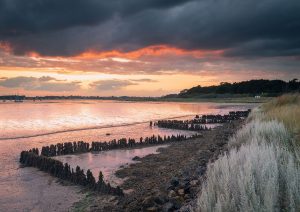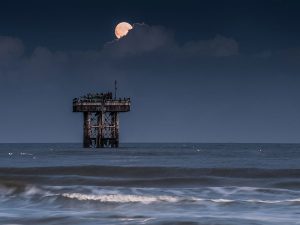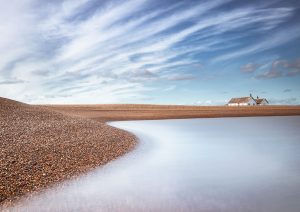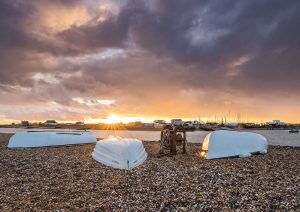Photographing the Suffolk Coast
Suffolk’s flat coastal landscapes are well known for their big skies and amazing light, two factors which have contributed to the rise in popularity of outdoor photography in the area.
Landscape photography provides a great opportunity to spend time outdoors and the search for a compelling images helps focus the attention on all the little details that might otherwise go unnoticed.Whilst many of us may be acquainted with the iconic views of Southwold Pier and the Aldeburgh Scallop Shell we are perhaps less familiar with the beauty of some of this coast quieter locations. I have discovered many in my photographic journey and have picked some of my favourites to share in this quick guide to photographing the Suffolk Coast.
Shingle Street
Shingle Street is a photogenic location which is growing in popularity with photographers. It is renowned for its continually changing shingle beach, its big skies and amazing light.
Unusually for one location it is ideal for both sunrise and sunset shots due to the shape of the shingle banks and is best visited at low or half tide. The shell line, which has been a feature of the beach since 2005, runs from the sea to the coastguard cottages and is one of Shingle Street’s most magical features and definitely worth seeking out for a photograph.
Bawdsey
This little hamlet at the mouth of the River Deben has much to recommend it as a photographic location. There are always little groups of dinghies on the beach to use in the foreground of your images and the view across the Deben to Felixstowe Ferry is always full of interest.
A little further inland East Lane in Bawdsey is one of my favourite coastal locations. The beach is a continually changing environment and there are some wonderful shots to be had at low tide across the exposed mudstone to the martello tower beyond.
Ramsholt
 This is a lovely location on the River Deben known for its attractive quay, its round tower church and its waterside pub. It is a great location for sunset shots across the River Deben. There are also good images to be had looking along the river using the shapes of the mud exposed at low tide or the strange triangular structures along the river’s edge. There is a footpath across the grazing marsh which affords good views of the church from across the reedbeds.
This is a lovely location on the River Deben known for its attractive quay, its round tower church and its waterside pub. It is a great location for sunset shots across the River Deben. There are also good images to be had looking along the river using the shapes of the mud exposed at low tide or the strange triangular structures along the river’s edge. There is a footpath across the grazing marsh which affords good views of the church from across the reedbeds.
All Saints Church is worth exploring. The churchyard is full of flowers in the summer including poppies, cow parsley and red valarian. Look out for the graves marked with skulls and crossed bones. The views out towards the river are wide ranging and beautiful.
Sizewell
 This location is most famous for its nuclear power station but don’t let this put you off. It has a lovely beach backed by marram grass and there are always a few fishing boats dotted around. Out to sea are a couple of metal structures which are associated with the power station and are home to colonies of cormorants and kittiwakes. These make good focal points for sunrise shots especially if framed by the marram grass at the back of the beach.
This location is most famous for its nuclear power station but don’t let this put you off. It has a lovely beach backed by marram grass and there are always a few fishing boats dotted around. Out to sea are a couple of metal structures which are associated with the power station and are home to colonies of cormorants and kittiwakes. These make good focal points for sunrise shots especially if framed by the marram grass at the back of the beach.
Photography tips
1. Plan your trip before you go. If you are heading to a new location look in local guide books for inspiration or search images on Flickr to give you an idea of what to expect.
2. Check the tide times and see what works with your chosen location. Some locations such as Shingle Street work best at low tide while others such as Woodbridge will be more picturesque at high water.
3. Use an app like the Photographers Ephemeris which will tell you the direction of the sunrise and sunset in relation to features on the ground www.photoephemeris.com
4. If you are not confident with full manual mode try shooting in aperture priority as this will give you more creative control over your images allowing you to manage the depth of field. Try shooting at F11 – F16 for full depth of field and front to back sharpness, or single out an element and isolate it from the background by choosing a shallow depth of field eg F5.6 – F2.8.
5. Try to vary your viewpoint. Getting down low and looking up can often create a more compelling image than one taken straight on at head height.
6. Remember observation in key. Spend some time looking around the location before reaching for your camera. Notice all the elements that are around you, including those in the foreground, middle distance and background. Think about the light and what direction it is coming from.
7. Slow your image taking down and spend some time thinking about your composition. What is your subject, what is your foreground interest, how can you link the two. What methods can you use to guide the viewers eye through your image. Think about compositional rules, but don’t be bound by them. They are there to guide your image making, not to define it.
For more ideas on where to go to take photos on the Suffolk Coast I have published a book “A Guide to Photographing the Suffolk Coast” which is available here.

